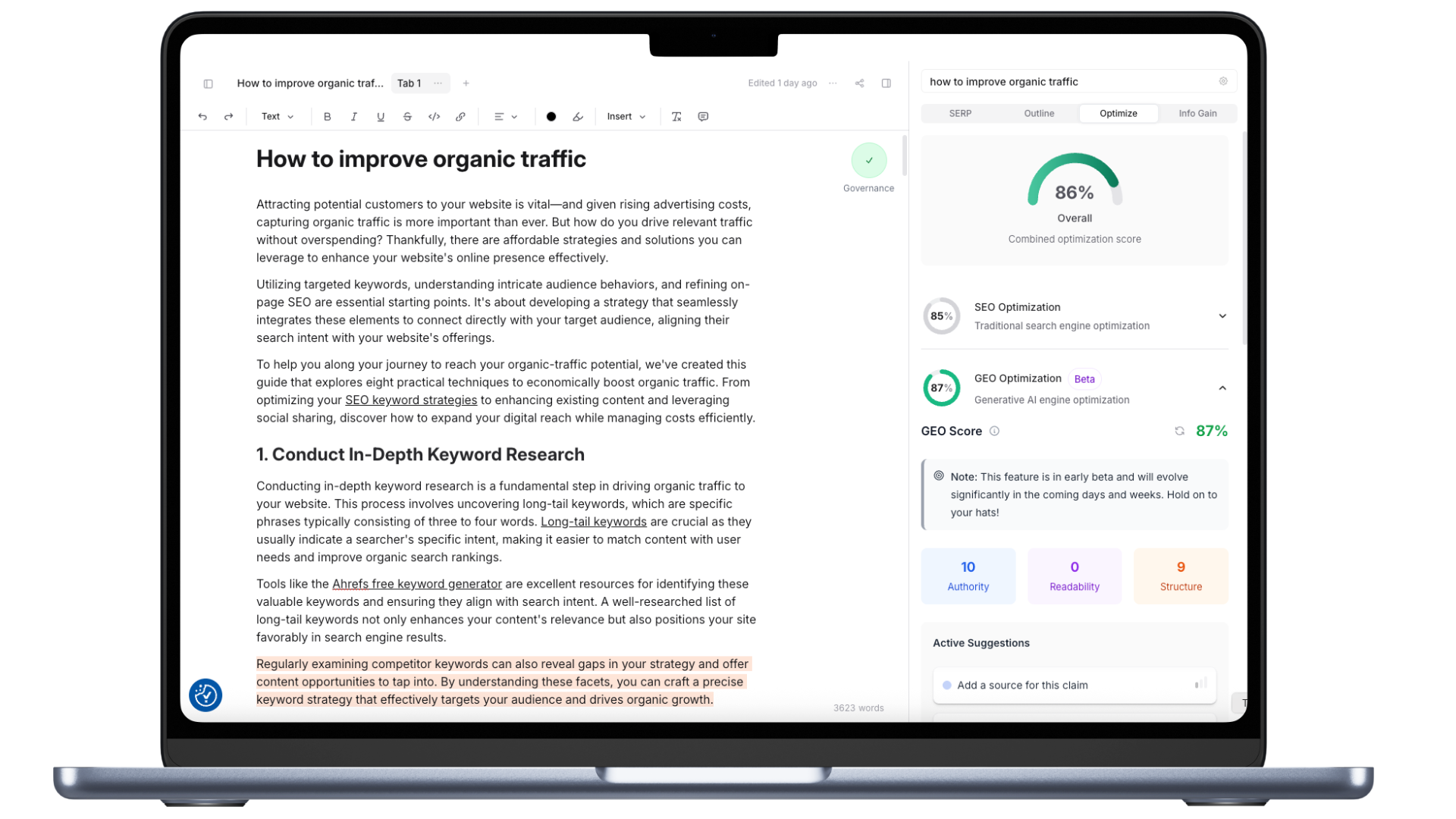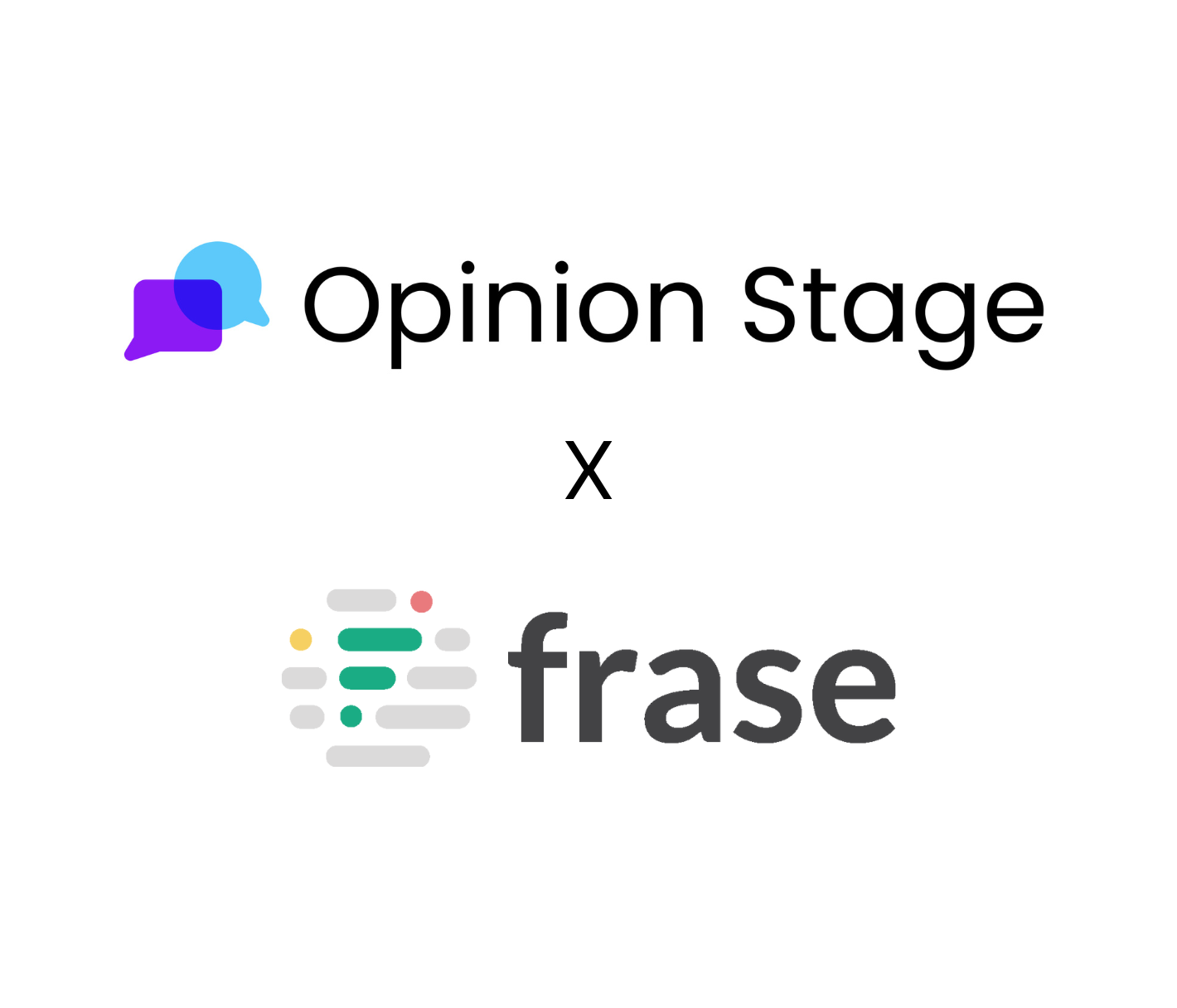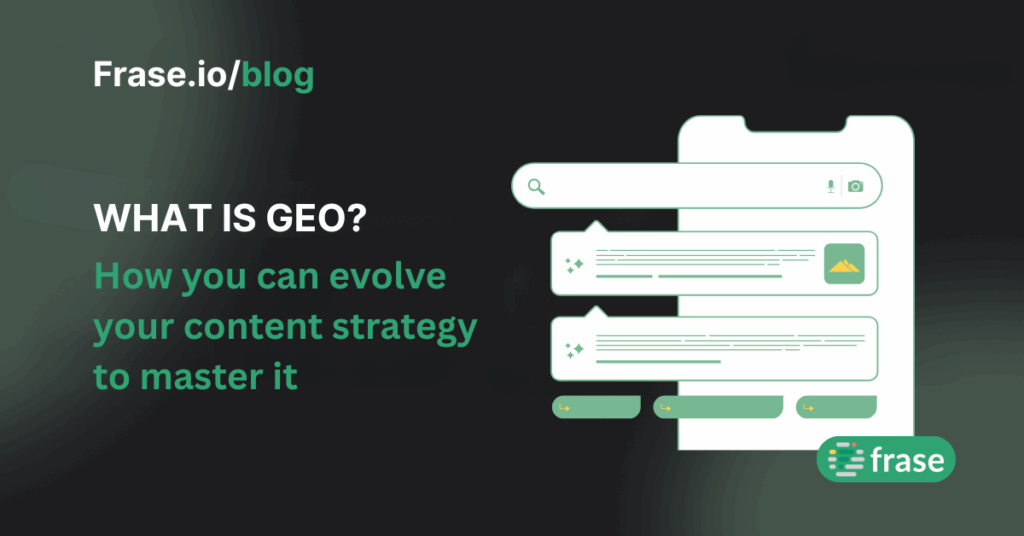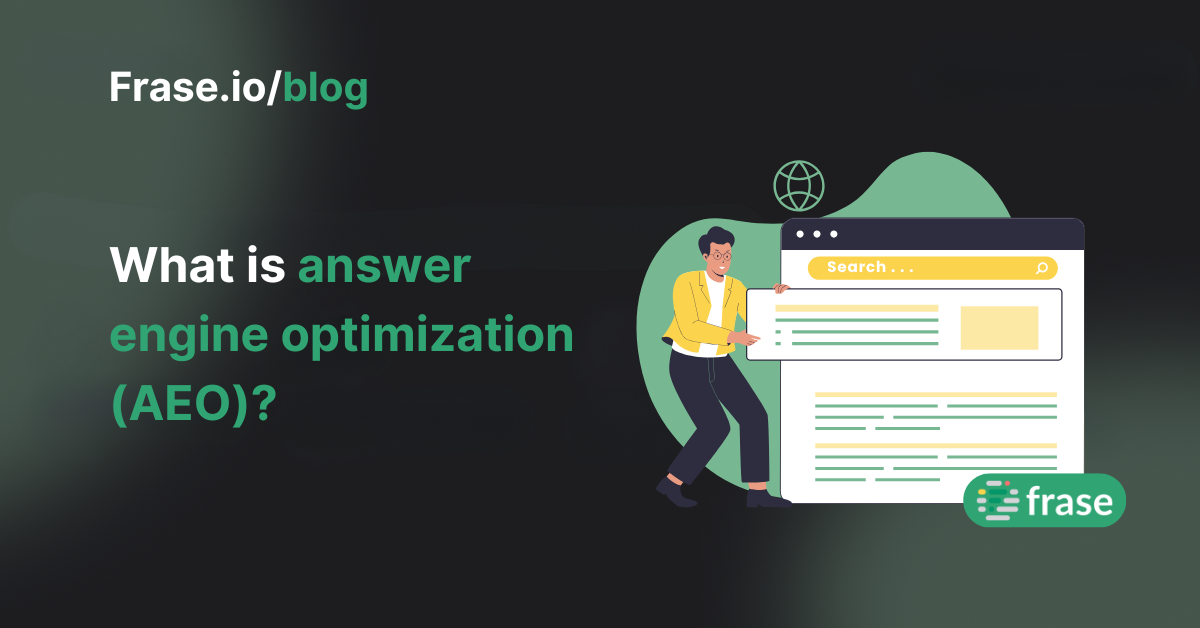What is generative engine optimization (GEO) and how you can evolve your content strategy to master it
SEO best practicesContents
One of the best things about working in the content creation world is you’re never bored—there’s always a new trend, a new tool to test, and new ideas to pin down. That has never been more true than it is right now.
One of the best things about working in the content creation world is you’re never bored—there’s always a new trend, a new tool to test, and new ideas to pin down. That has never been more true than it is right now. In content creation, we are constantly thinking about how we can strategically produce blogs, videos, infographics, and other assets that create more brand visibility on search engines and other channels. But with the introduction of generative engine optimization (GEO), our playbooks have been flipped on their heads.
If you’re wondering what generative AI means for you and your team, just know, you’re not alone. All content creators are hustling to uncover how to adapt their content strategy and workflows to master this new frontier.
And because at Frase we are absolutely obsessed with helping your brand be discovered everywhere (from generative AI platforms, to search engines and beyond), we’ve put together this comprehensive look at everything you need to know about GEO, complete with actionable ideas for how you can adapt your existing content process.
Are you ready to master GEO content? Let’s go!
Defining SEO, AEO, and GEO
It goes without saying: AI-powered search is taking over. Even the simplest queries are now answered by generative results from platforms like ChatGPT, Google Gemini, and Perplexity. In fact, ChatGPT has over 180.5 million monthly active users, while Perplexity AI’s search volume has surged by 858% in the past year and it now has around 10 million active monthly users.
To stay competitive, content creators (like us) need to understand how to optimize for both search engines to generative AI platforms—and that starts with understanding the differences between SEO, AEO, and GEO. Here’s a quick acronym dictionary for you:
What is search engine optimization (SEO)?
Search Engine Optimization (SEO) focuses on optimizing content to rank well on traditional search engines like Google. By targeting the right keywords, structuring content strategically, and implementing strong metadata (titles, headers, descriptions), SEO drives organic traffic through search result visibility.
What is answer engine optimization (AEO)?
Answer Engine Optimization (AEO) takes it one step further. Rather than just ranking, AEO is about being the answer. By directly addressing common user questions—think “who,” “what,” “where,” “when,” “why”—in clear, structured formats like bullet points or FAQs, your content is more likely to be quoted in search engine featured snippets or answer boxes.
What is generative engine optimization (GEO)?
Generative Engine Optimization (GEO) is the evolution of both to meet the requirements of generative AI. It ensures your content is not only searchable but also discoverable and referenced within AI-generated responses. GEO makes your content part of the conversation—literally—within tools like ChatGPT, Gemini, Bing Copilot, Google AI Mode and other AI interfaces that are becoming the front door to the internet.
What are the differences between SEO, AEO, and GEO?
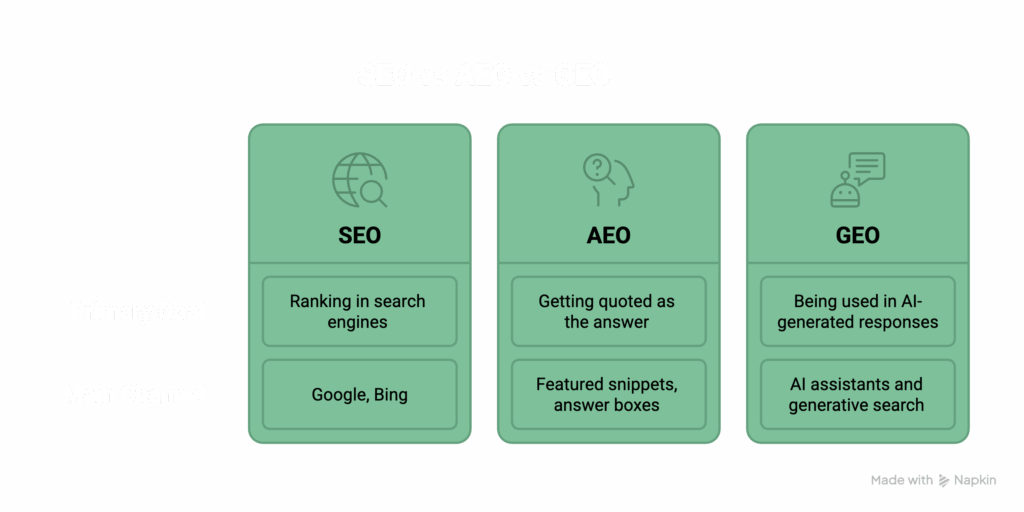
From search engines to generative engines: How digital marketing has evolved
To sum up this evolution, digital marketing used to be about search results and keyword dominance. But now, it’s about being AI-readable. Consumers increasingly turn to generative AI tools for answers instead of scrolling through ten blue links. This shift means your content must not only be well-optimized but also structured and authoritative enough to be referenced by generative engines.
Generative engine optimization requires a focus on readability, authority, and structure. It’s not just what you say—it’s how you say it, and whether AI sees it as the best available answer.
The future of GEO
Generative AI has already become a peoples’ daily lives, making GEO a must-have strategy—and that will only continue to intensify. But don’t just take it from us. Gartner predicts a significant drop in traditional search volume by 25% by 2026, with organic search traffic expected to decrease by over 50% as consumers embrace AI-powered search.
This isn’t a trend—it’s the future. Marketers must be agile, forward-thinking, and ready to create content that AI recognizes as trustworthy, helpful, and worth surfacing. Those who adapt early will enjoy stronger brand visibility and deeper user engagement.
What do you need to create a successful GEO strategy?
A successful GEO strategy hinges on three key principles: Authority, Readability, and Structure.
Authoritative content
Generative engines prioritize trustworthy, expert-backed content when constructing answers. The more authoritative your content appears, the more likely it is to be cited or featured in AI-generated results. Here’s why it makes a difference:
- Trust signals for AI: Engines look for cues like credentials, backlinks, and citations to determine credibility.
- Higher ranking in generative summaries: Authoritative content is more likely to be pulled into AI answers and zero-click responses.
- Increased likelihood of citation: Content that demonstrates deep expertise is more quotable by LLMs.
- Builds user trust: When your content is selected, authority reassures users that the information is reliable and worth engaging with.
A recent research study by Princeton found that GEO methods like the inclusion of citations, quotations from relevant sources, and statistics notably boosted source visibility by over 40% across various queries.
Strategies to increase content authority
- Prioritize the EEAT principles (Experience, Expertise, Authoritativeness, Trustworthiness)
- Cite first-party data, expert sources, or real-world experience
- Maintain a natural, human tone—even when writing for machines
- Avoid keyword stuffing as you want your content to sound natural and conversational.
- Focus instead on rich, meaningful language and well-structured information.
Wondering how you can identify areas where you can add citations to increase authority? Frase’s Content Optimization has you covered with GEO Score!
Readable content
Readability is essential for GEO because it helps AI models accurately interpret and surface your content in generative search results. Clear, well-structured content is more likely to be summarized correctly, cited by AI, and appreciated by users. Here’s why it matters:
- AI-friendly language: Simple, concise writing is easier for generative engines to understand and extract insights from.
- Accurate summaries: Readable content improves how your message is captured and represented in AI-generated responses.
- Better user experience: Easy-to-scan content keeps users engaged and reduces bounce rates.
- Structured formatting: Clear headings and sections help LLMs navigate and reuse your content effectively.
Strategies to increase content readability
Readability is critical. AI and human readers both prefer:
- Concise paragraphs
- Simple sentence structures
- Informative subheadings
- Strategic use of visuals (charts, screenshots, infographics)
Be sure to avoid:
- Jargon
- Over-crowded sentences
- Filler and fluff
Use tools like Hemingway, Grammarly, or even AI eye-tracking simulators to test how digestible your content is. And make updating a habit—fresh, relevant content is more likely to be indexed and surfaced by generative engines.
Frase’s generative engine optimization capabilities identify areas where you can increase readability, even providing suggested copy to simplify your message and increase AI discoverability.
Content with clear structure
Finally, structure is important for Generative Engine Optimization (GEO) because it helps AI models understand, segment, and reuse your content more effectively. Well-organized content increases the chances that generative engines will surface the right information at the right time. Here’s why:
- Improves content scannability: Clear headers, bullet points, and sections help LLMs quickly locate key information.
- Enables precise citation: Structured content allows AI to pull specific, self-contained snippets into answers.
- Supports follow-up prompts: Logical flow makes it easier for AI to interpret context and respond to layered queries.
- Enhances zero-click visibility: Clean formatting increases the odds of your content appearing in featured summaries or AI previews.
Strategies for improving structure
Use headers, subheads, and list formats to make your content easy to scan and digest.
Frase can be especially helpful here! We help you to build content briefs with clear headings and question blocks designed with your target keyword in mind in just minutes. Check it out below:
Use AI tools (like ChatGPT or Claude) during your research phase to uncover recurring patterns in AI answers, common phrasing, and keyword clusters. This will help you reverse-engineer what LLMs prioritize and ensure your content is aligned.
Frase’s GEO Score lets you know where your can improve your structure—check out this prompt it gave our team about a recent blog:
Conducting a GEO readiness audit
Before diving into GEO, take stock of where you stand. A readiness audit should assess:
- Your current content structure and metadata
- Your ability to provide authoritative, original insights
- Your use of clear, query-based formatting
- Any technical limitations (e.g., CMS restrictions, outdated web infrastructure)
This helps identify opportunities to align your team, tools, and content creation processes with the demands of generative AI visibility.
Your step-by-step guide to getting referenced by generative AI
The GEO strategy workbook walks you through 7 critical exercises that will help you hone in on a practical, repeatable system that will set your content up for success in the new age of search.
Get Access7 ways to adapt your content workflow for GEO
To truly optimize for GEO, you’ll need to rethink your content production process. Here’s how to start:
1. Incorporate AI into content planning
Use AI tools to research trending topics, keyword clusters, and common user questions. This can shape your editorial calendar around what audiences—and generative engines—are most likely to find useful.
2. Start with answer-first outlines
Structure content like an answer engine would. Begin your outline with direct answers to likely search queries, followed by supporting details, examples, and visual elements. This helps AI search models extract key points quickly.
3. Create multi-format content from the start
Plan every article with repurposing in mind. GEO-optimized content should also be broken into carousels, snippets, videos, or infographics—formats that generative engines and platforms like Gemini increasingly favor.
4. Maintain a content governance framework
Establish internal brand voice and style guides, reusable templates, and content taxonomies that standardize formatting across your website and ensure content quality. Consistency helps both humans and machines recognize your content as reliable.
5. Assign roles for content QA and fact-checking
Accuracy and authority matter more than ever. Assign team members (or AI tools) to validate claims, ensure citations are up to date, and double-check EEAT compliance.
6. Use structured data
Enhance how your content is understood by both AI and traditional search engines by using structured data. Add schema for articles, FAQs, authorship, and reviews where relevant.
7. Build a feedback loop using AI analytics
Use AI tools to track performance: which content is being surfaced in AI overviews, how users are interacting with generative results, and what patterns are emerging. Use those insights to continuously refine your content.
What are the benefits of implementing GEO tactics?
Stronger brand visibility
GEO helps ensure your brand’s voice is included in AI conversations—before users ever click a link.
Improved user engagement
By creating content that’s accessible and useful, you’ll hold attention longer and increase the likelihood of conversion.
Competitive edge
Early GEO adopters are positioning themselves ahead of the curve in an AI-first digital future.
Increased traffic from AI sources
More AI visibility = more impressions, higher trust, and new sources of inbound traffic from platforms that traditional SEO can’t reach alone.
What are the challenges and considerations around GEO?
GEO is still an emerging tactic, and its rules are evolving fast. Be prepared for a dynamic environment:
- AI platforms may change how they attribute or surface content.
- Standards for authority and trust will continue to tighten.
- Integrating GEO with SEO and AEO requires ongoing refinement.
Still, GEO isn’t about replacing existing strategies (after all, traditional search engines are not going away). It’s about enhancing them for the next generation of search. Your content workflow will need to integrate new strategies with your existing ones, allowing you to own traditional search results with your old-faithful search engine best practices, be known as the brand with the answers your AEO tactics, and build your authority with AI search engines. This way, your brand will become a triple threat!
How to fast track GEO adoption with Frase
If you’re ready to embrace generative engine optimization but unsure where to start, Frase has you covered. Our platform now includes GEO Score—a powerful new feature designed to help content creators, marketers, and SEO teams seamlessly integrate GEO into their existing workflow.
GEO Score gives your content a real-time grade based on the three essential signals that generative engines prioritize: Authority, Readability, and Structure. Instead of guessing whether your content is reference-worthy, Frase surfaces the insights you need to take action. It identifies missing citations, flags overly complex passages, and highlights structural gaps—so your content doesn’t just rank, it gets surfaced, cited, and shared by AI.
What makes this game-changing is that GEO Score is fully embedded into the Frase workflow. From content research to outlining, writing, and optimization, you can now create AI-ready content without leaving the platform. It’s a streamlined, data-backed approach to content creation that empowers you to move fast and stay ahead—without sacrificing quality or visibility.
With Frase, adopting GEO doesn’t mean overhauling your process. It means upgrading it. Start using GEO Score today and see how effortless it can be to optimize for both search engines and generative engines—at the same time.
Watch the video below to see how easy it is to implement GEO into your existing content workflow with Frase:
Final thoughts
Generative Engine Optimization is more than a buzzword—it’s a new way of thinking about search visibility.
As AI search becomes the default interface for discovering information, your content must evolve to meet it there. By building high-quality, structured, and authoritative content that’s designed for both humans and machines, you’ll not only increase visibility—you’ll shape the future of your digital brand.
Learn how Frase can help your brand create content that gets discovered everywhere
Check out GEO Score in Frase today—no payment required.
Get Started with GEO